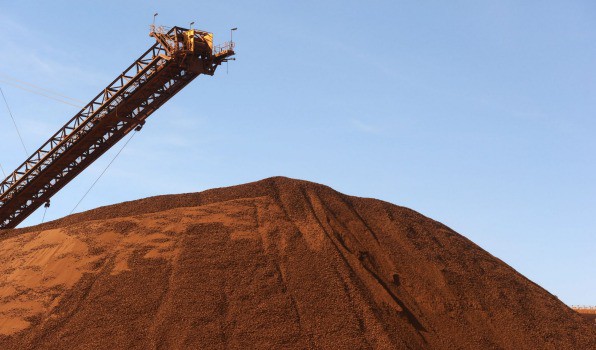
Australia’s iron ore industry will contribute more to the nation in the next decade than it did through the mining boom, and history shows that any market intervention would be “ineffective at best and counter-productive at worst”, a new report says.
Australian producers’ race to increase capacity has set them up to generate $600 billion in revenue over the next decade, even with the huge recent collapse in prices, and assuming no production growth. That compares to $430 billion in the decade from 2005 to 2014.
That forecast is part of a new report into the industry by independent consultancy firm Port Jackson Partners, commissioned by peak mining lobby group, the Minerals Council of Australia.
It is a look at the “questions raised” this year over the state of the industry and the “debate about whether the industry or government policymakers could have acted to ensure Australia would now be in a different, higher priced world”.
Fortescue chairman Andrew Forrest has previously accused Rio Tinto and BHP Billiton of flooding the market with iron ore, increasing supply at a time when prices were falling, and talking the market down.
He failed to win support for a Federal parliamentary inquiry into the iron ore industry earlier this year, but continues to wage a campaign against his bigger Pilbara rivals at a grassroots level. Attempts by the Fortescue Metals Group camp to pitch a state inquiry in WA have so far been unsuccessful.
The report says that since 2000, Australia’s seaborne market share has grown by 16 percentage points – from 34 per cent to 50 per cent … and volume is replacing price as the source of iron ore growth. Of the 450 million tonnes installed by the domestic industry, about 250 million was needed to keep up with market demand. The 200 million-tonne balance represents an increase in market share.
Importantly, iron ore is the only major resource commodity Australia has increased its market share in since 2000 – the others have all gone backwards. And the iron ore industry has hammered down its cost position while doing so.
“From a national interest perspective, Australia needed the market share growth to outweigh price declines,” chief author Grant Mitchell wrote. “Without it, the industry’s contribution to wealth would be smaller in the next decade than in the one just past.”
Iron ore players “who did not recognise that prices could, and probably would, fall back to levels approaching long-run averages were running against the tide of evidence and the bulk of market views”. It was naive to suggest that market conditions of the past “boom” decade would persist.
“The case for ‘doing something differently’ seems to arise from a dissatisfaction with the way markets work, the role of Australian iron ore producers within them, or a belief that something about the way the Australian industry has evolved means ongoing, unrestricted exposure to the iron ore market is no longer wise,” the report said.
“The evidence in fact supports completely the opposite diagnosis: the global iron ore market is operating as it should, and as all mineral commodity markets do … global forces, not Australian miners, are responsible for price movements, both up and down.”
It made “little sense” to link Australia’s market share to the retreat from record prices.
In the next 10 years, even if the Australian iron ore industry achieves no further growth, corporate taxes should grow to $81 billion, from $71b in the decade to 2014. while state royalties should grow to $40b, from $28b. Employee payments are tipped to hit $78b in the period, from $45b over the past decade. Port Jackson Partners’ revenue forecasts over the next decade don’t take into account the 107m tonnes classified as “committed”.
Australian producers expanded their production appropriately to date, in response to price signals – it was “entirely commercial behaviour”, the report said.
The AFR understands that the long-term consensus price estimate used in the report is $US72 a tonne, not including freight, at an exchange rate of 75 cents – higher than the $US74 a tonne price averaged in the past decade. Iron ore prices have deteriorated in the last two days, losing about 8 per cent to $US54 a tonne. Over the past decade, the iron ore price peaked at 5.6 times its average price from 1980 to 2005, while other commodities tripled or doubled.
Australia’s gain in market share is “remarkable, not a drawback”, particularly given “Brazil has the necessary resources and the demonstrated ambition to accelerate volume growth”.
Any attempts to improve the iron ore price through centralised marketing, or otherwise controlling production, would be “ineffective at best and counter-productive at worst”.
If Australia were to restrict production artificially, to avoid “flooding the market” with cheap supply, it would ignore the benefits demonstrated from active competition to gain market share, and the “almost inevitable” backlash from customers associated with supply restrictions.
The Australian iron ore industry’s last attempt at this policy experiment – in the 1970s and 80s – failed, and Brazil reaped the rewards. Australia introduced export controls in iron ore which, along with industrial relations issues, encouraged Japanese steel mills and trading houses to invest in Brazil’s industry instead.
Source: Australian Financial Review